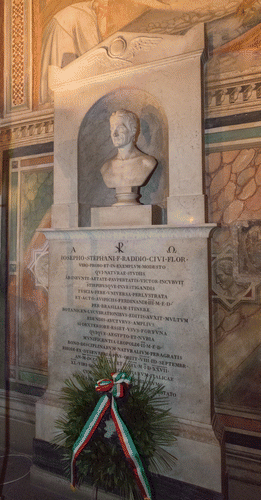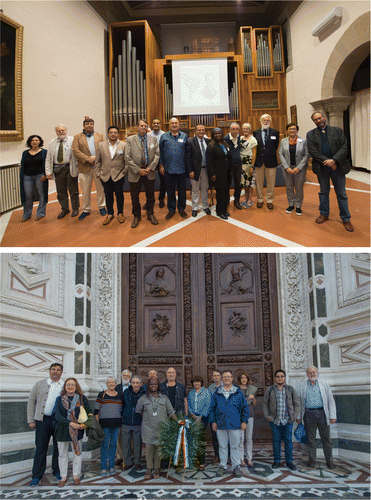A Symposium organised by Centro Studi Erbario Tropicale-Tropical Herbarium FT of the University of Florence and held at the Auditorium of ‘Fondazione Cassa di Risparmio di Firenze’, Florence, 5 October 2017.
A thorough knowledge of the highly diverse Neotropical Flora represents one of the most urgent and crucial aspects of current plant taxonomy and geography. In this context, we cannot ignore the contribution of the first explorers and scholars focused on Neotropics, the first pioneers of the Pre-Linnaean age (e.g. Georg Marcgrav, Hans Sloane and Charles Plumier), as well as those eighteenth- and nineteenth-century botanists, who followed the ideas of Linnaeus.
During the eighteenth and nineteenth centuries, there was a deep interest in the exploration of overseas lands in relation, above all, to the economic and colonial benefits of the great European countries such as, in particular, Spain, France, Great Britain, and later Germany and Austria.
Certainly the ‘Linnaean Revolution’ and the advent of botany as a science based on observation, description, diagnostics and classification had favoured a critical and scientifically objective vision of Nature, in which cultural relationships and exchanges between scientists and scholars in many countries took on a fundamental meaning not easily appreciated in today’s globalised world.
The role of the great European natural history museums also represented a tool of accumulation of scientific information and ideas, although this may now seem difficult to understand in the light of what is currently possible in the modern world and the modern media and technology.
In this context of scientific innovation, the contribution of Italian scholars also played a significant role, despite the fragmented political and cultural situation at the time in what is now Italy. For these reasons the contribution to the knowledge of the Flora of Brazil by Giuseppe Raddi should not be ignored today, particularly in 2017, 200 years after his trip to Brazil.
Despite his immense contribution to the knowledge of the Flora of Brazil, Raddi and his precious botanical collections and works are currently often forgotten, not least by young scholars.
On 5 October 2017, the Centro Studi Erbario Tropicale (CSET) dedicated a day of reflection and study to Raddi’s memory, not least thanks to the participation of specialists in Neotropical Flora, recalling Raddi’s always difficult and sometimes tormented family and working life in Florence, seen against the background of the political situation in Italy and Europe at the turn of the eighteenth and the first half of the nineteenth century.
This initiative was made possible thanks to the contribution of the Cassa di Risparmio di Firenze Foundation that has continued to support the CSET also with a grant for this third international symposium, following two previous international meetings: ‘One Hundred Years of Tropical Herbarium in Florence 1914–2014’ and ‘Past, Present and Future in Tropical Botany: Taxonomy, Data Archiving, and Genomics’, which were held in 2014 and 2016, respectively.
The presentations at this symposium have dealt with Giuseppe Raddi’s biography, seen both as a person and a scientist, with the historical context in which he acted, and with his scientific legacy. This was made possible by CSET being able to invite scholars with long experience with the study of Tropical Botany, as well as experts in archival documentation.
The result was gratifying and much appreciated by a public audience, which included not only insiders from the CSET and other botanists at the Università degli Studi di Firenze and other Italian universities, but also students and citizens of Florence, representing the reputation of such an illustrious Florentine as Giuseppe Raddi, whose memory is celebrated with a monument dedicated to him in the Santa Croce Cathedral, the Pantheon of the great Italians. The day after the symposium, on 6 October, a requiem mass was also celebrated in Santa Croce Cathedral, as well as the laying of a wreath to the memory of Raddi at his monument (Figures ).
Figure 1. Giuseppe Raddi’s monument in the Santa Croce Cathedral in Florence. (Centro Studi Erbario Tropicale, herbarium FT photo archive).

Figure 2. Upper photo: Cassa di Risparmio di Firenze Foundation’s Auditorium. Lower photo: a moment during the Symposium talks. (Centro Studi Erbario Tropicale, herbarium FT photo archive).

Figure 3. Upper photo: group of participants at the Symposium. From left to the right: Maria Grazia Pontormo, Ib Friis, José Rafael Raddi, Orlando O. Ortiz, Paulo G. Windisch, Iván Valdespino, Piero Delprete, Riccardo M. Baldini, Zita Regina Da Silva Baldini, Hugh Harries, Jane Harries, Ghillean T. Prance, Annalisa Managlia, Renzo Nelli. Lower photo: group of participants at the celebration day in Santa Croce Cathedral in Florence. From left to the right, front row: José Rafael Raddi, Marta Mariotti Lippi, Jane Harries, Hugh Harries, Zita Regina Da Silva Baldini, Riccardo M. Baldini, Orlando O. Ortiz, Ib Friis. Back row: Ghillean T. Prance, Robert Mayo, Piero Delprete, Maria Hartl, Paulo G. Windisch, Lia Pignotti. (Centro Studi Erbario Tropicale, herbarium FT photo archive).

The scientific contributions were introduced by Riccardo M. Baldini, director of CSET (FT Herbarium) with a detailed review of Giuseppe Raddi’s life, scientific career and work, entitled ‘Giuseppe Raddi (1770–1829): a Florentine naturalist, pioneer on Brazilian territory’, in which most attention was given to his trip to Brazil and to his role as the first true monographer of the Brazilian Flora.
Many aspects of Raddi’s difficult life were dealt with in the light of his complex working relations with staff members and leadership of the Museum of Natural History of Florence, especially during the beleaguered period of Napoleonic domination of Toscana.
The following talk by Sir Ghillean T. Prance of the Royal Botanic Gardens, Kew, entitled ‘Following in the footsteps of Giuseppe Raddi’ reported on the consequences of Raddi’s trip to Brazil and his role as a pioneer of the study of the Brazilian Flora. Prance focused not only on Raddi’s immense contribution to the Brazilian plant taxonomy, but also on the legacy he left to the following botanists, including von Martius and Spix and other botanists behind the future Flora Brasiliensis. Prance focused particularly on Raddi’s work as a basis for the following studies and exploration of the Amazonian Brazil, and mentioned other important European botanists, collectors and explorers up to today, all drawing on his immense personal experience in that area of Brazil over more than 50 years of studies and research.
Paulo Günter Windisch from the University of Porto Alegre, a specialist in Pteridology, which is one of the most important subjects in Raddi’s research, gave a talk entitled ‘Raddi’s visit to Brazil in a historical perspective’, in which many details of Raddi’s scientific background were outlined, as well as his cultural influence on contemporary and future botanists. Windisch also pointed out the relationship between Raddi and other international scholars, which were the consequences of the journey to Brazil made on the occasion of the marriage between Archduchess Maria Leopoldina of Austria and Dom Pedro de Bragança. Finally, Windisch presented a status report of our present knowledge of Raddi’s botanical collections.
The talk presented by Piero Delprete of the Institut de Recherche pour le Développement (IRD) UMR AMAP, Herbier de Guyane, Cayenne Cedex French Guiana (France) was entitled ‘Giovanni Casaretto and his botanical collections in Brazil and Uruguay’. It can be considered a tribute to Raddi through the work of one of his Italian followers. In fact, apart from a rather different life story than the one of Raddi, Giovanni Casaretto was also a prolific botanist – even if his productivity did not reach the level of Raddi’s. Casaretto managed to describe 100 new species of Dicotyledons from the Mata Atlantica (Portuguese for ‘the Atlantic Forest’), a zone originally rich in forests, extending along the Brazilian coastline from Rio Grande do Norte in the north to Rio Grande do Sul in the south and also including Uruguay. Delprete presented all aspects of Casaretto’s contribution to the Flora of Brazil, including a detailed reconstruction of his botanical collections, which was based on his recent publication on this topic (see Phytotaxa 253 (1), 2016).
The two following talks did not focus specifically on Raddi, but dealt with some specific aspects of Neotropical Botany.
Orlando Oriel Ortiz from the University of Panama, a promising young botanist focusing on Central American botany, introduced the genus Anthurium (Araceae) with a talk entitled ‘Biodiversidad de la Familia Araceae en Panamá’, which was a scholarly presentation of one of the most important genera represented in Mesoamerica, particularly in Panama. The work of Ortiz shows how and why the new generation of botanists in the Neotropics is so important for the scientific and cultural development of those areas of the world.
Hugh Harries (Coconut Time Line (UK)) is a specialist in the family Arecaceae, and especially the coconut, Cocos nucifera L. He presented a talk entitled ‘The Cradle of the coconut: Emilio Chiovenda’s “La Culla del Cocco (1921–1923) revisited’. Harries’s talk was a very intriguing one, demonstrating how the origin of Cocos nucifera L., in spite of the species’ present pantropical distribution, is not yet sufficiently well known. The talk also gave occasion to remember the contribution of two other important Italian tropical botanists: Odoardo Beccari and Emilio Chiovenda.
Towards the end of the day, the two following talks on museologi and archival matters represented a return to Giuseppe Raddi: one was given by Annalisa Managlia, keeper of the Herbarium Bononiensis (BOLO), and another by Renzo Nelli, Librarian at the Department of Biology, Science Library – Botanical Section Library.
Annalisa Managlia’s talk was entitled ‘The contribution of Giuseppe Raddi to Antonio Bertoloni’s collections at the Herbarium of the University of Bologna’ and included a detailed report on the friendly relations between Giuseppe Raddi and Antonio Bertoloni, and on the collections of Raddi as studied by Bertoloni, including the current project on their digitalisation at BOLO.
Renzo Nelli’s talk entitled ‘L’archivio di Giuseppe Raddi nella Biblioteca di Scienze – sez. Botanica (Giuseppe Raddi’s Archive at the Science Library ‘ Botanical section’) introduced the complexity of the archive of Raddi’s manuscripts kept at the Library of the Department of Biology of the University of Florence. I can say that this talk represented a true novelty in the study of Raddi’s life and scientific work, opening new possibilities for very interesting future studies and contributions.
I am personally very proud of the outcome of this third symposium, which has been organised by CSET in less than three years. After the centenary of the FT Herbarium celebrated in 2014, and the second event in 2016, dedicated to the importance of the historical botanical collections as tools in plant taxonomy, this latest symposium represents a sort of synthesis of the previous ones, focusing on one important, early nineteenth-century botanist, Giuseppe Raddi, and his contributions, efforts and constant tenacity, which gave us the opportunity to feel ourselves part of an extraordinary scientific discipline, tropical botany, with the honour and responsibility to continue and carry on the grand task of describing and understanding the tropical flora. Definitely, at this symposium we saw Giuseppe Raddi as an example of a genuinely productive and internationally oriented scientist, an example for all of us who are often too reluctant to open ourselves to the world.
Department of Biology, Centro Studi Erbario Tropicale, University of Florence, Italy
[email protected] http://orcid.org/0000-0003-2181-3441
